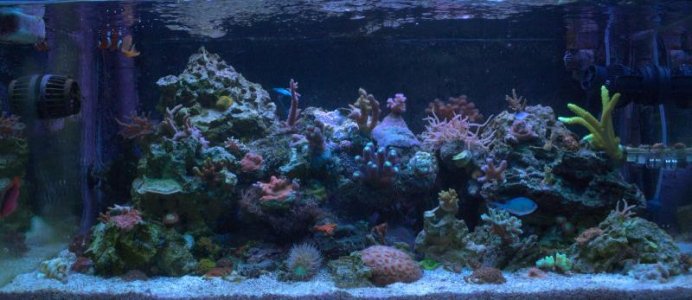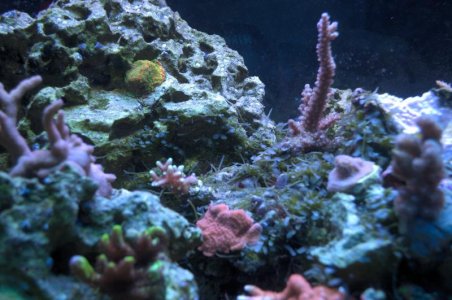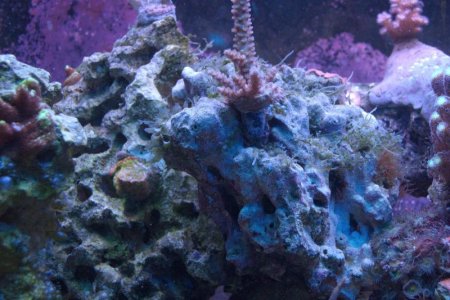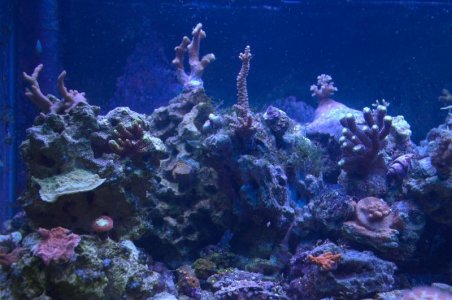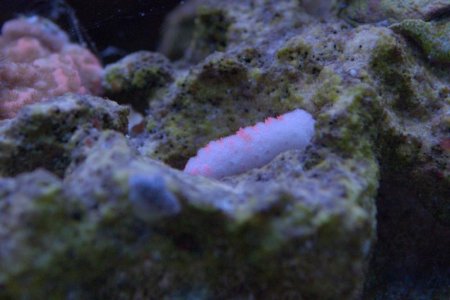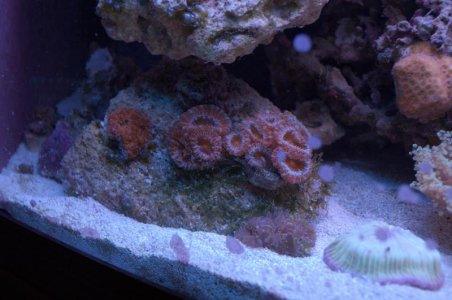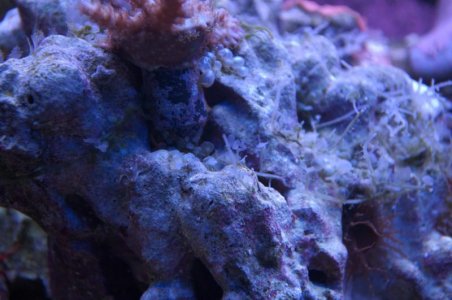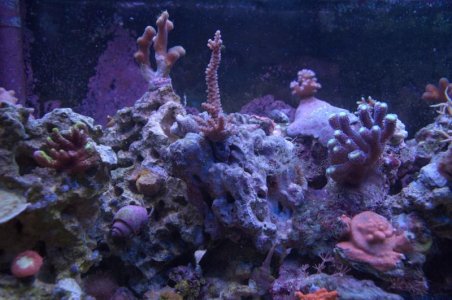I just wanted to thank you Brandon. Your dedication to helping folks rid their tanks of nuisance algae is much appreciated. I'm happy to report that injecting my bubble algae killed it completely. :thumbsup:
You are using an out of date browser. It may not display this or other websites correctly.
You should upgrade or use an alternative browser.
You should upgrade or use an alternative browser.
pico reef pest algae problem challenge
- Thread starter brandon429
- Start date
brandon429
Active member
Sugar thank you for your follow up im so happy that one worked!!!! Valonia wont always die and stay gone I had such a hard time trying to get mr snakebyts tank fixed I'm always glad to hear when it does work!
brandon429
Active member
Thanks for posting! That bright pink change is the death knell indicator for any rhodophyta variant...that's way faster than i predicted but a good sign nonetheless.
You can easily start in tank treatments if you want to try one, we had discerned on your topside thread that there aren't particular sensitives in your tank besides a little chaetomorpha. Simply doing one patch at a time, underwater, as a little test run is a fractional exposure of your tank to the peroxide it could handle.
Still, especially when I've solicited the trial i like to be really slow to keep a perfect safety record for the thread.
We are at the point we need some kind of injectable though...to hit the rocks under water we need a directed delivery, i use a little plastic eye dropper but I'm sure nothing beats a diabetic syringe and needle. Sure, you will feel like a crack head buying them but this is for science baby! Lol
but this is for science baby! Lol
Optimally, you use the medicine bottle or temporary underwater Saran wrap to hold the peroxide on the target briefly
But I'll tell you a secret...that hot pink change within hours indicates a highly susceptible target and you probably don't need to.
I bet fully you can beat this slowly, one patch or just a couple at a time, simply turning off pumps (this still increases localized contact time) and slowly injecting right in the middle of each patch a few mls of peroxide. I guarantee you can try one tonite no harm but you need a tool of some kind to do it.
Inject or squeeze eye dropper very slowly so that peroxide touches the mass as much as it can before its carried off into the tank. One test run on a submerged patch will let us know if we want to shift to that method instead.
If its worth the work however, still lift out what you can for best results.
The final test hasn't been seen yet for your tank...grow back potential. I hate to see you do a bunch of effort until some test patches are totally gone and we can see if they stay gone.
But the point is look how powerful the method would have been on the first few spots...it's great to have in the future if needed, to catch anything early on and zap it!
You can easily start in tank treatments if you want to try one, we had discerned on your topside thread that there aren't particular sensitives in your tank besides a little chaetomorpha. Simply doing one patch at a time, underwater, as a little test run is a fractional exposure of your tank to the peroxide it could handle.
Still, especially when I've solicited the trial i like to be really slow to keep a perfect safety record for the thread.
We are at the point we need some kind of injectable though...to hit the rocks under water we need a directed delivery, i use a little plastic eye dropper but I'm sure nothing beats a diabetic syringe and needle. Sure, you will feel like a crack head buying them
Optimally, you use the medicine bottle or temporary underwater Saran wrap to hold the peroxide on the target briefly
But I'll tell you a secret...that hot pink change within hours indicates a highly susceptible target and you probably don't need to.
I bet fully you can beat this slowly, one patch or just a couple at a time, simply turning off pumps (this still increases localized contact time) and slowly injecting right in the middle of each patch a few mls of peroxide. I guarantee you can try one tonite no harm but you need a tool of some kind to do it.
Inject or squeeze eye dropper very slowly so that peroxide touches the mass as much as it can before its carried off into the tank. One test run on a submerged patch will let us know if we want to shift to that method instead.
If its worth the work however, still lift out what you can for best results.
The final test hasn't been seen yet for your tank...grow back potential. I hate to see you do a bunch of effort until some test patches are totally gone and we can see if they stay gone.
But the point is look how powerful the method would have been on the first few spots...it's great to have in the future if needed, to catch anything early on and zap it!
maddmaxx
New member
well after dinner I got bored while looking at the tank. I took out every piece possible that wasn't a base foundation rock and hit it wit peroxide. I took out a lot. most of the pieces I did remove and dose turned a very pale white within a few hrs after treatment. I do have an plastic syringe that I can use for under water applications. and good call on turning the flow off. prolly would have over looked that lil detail. but makes total sense..
brandon429
Active member
Excellent feedback, I wanted to go ahead and link up your thread, wonderful before pics:
http://reefcentral.com/forums/showthread.php?t=2320635
http://reefcentral.com/forums/showthread.php?t=2320635
maddmaxx
New member
Ok 4 days later. all signs of the cotton candy that I dosed wit peroxide had disappeared. seems like everything died off or got eaten from the Mexican turbos. heres a pic of the same rock after 4 days. (rock work is different cause of me pulling rocks out, treating them, then replacing them back into the main display)


maddmaxx
New member
HOWEVER. the lower base rocks are not as nice lol. and I do see very early stages of the cotton candy on other rocks, for some reason, the Mexican turbos don't touch this algae tho. and I don't understand why, ive read many threads that they go after this stuff.... heres a pic of what the lower rocks starting to look like. not all, this particular rock is prolly the worst one I have...


brandon429
Active member
thanks much for the follow up
it seems your variant simply needs better exposure than passive underwater dosing. if you can find a way to cap in that peroxide, and use an injector tool, the saran wrap method or the medicine bottle method will fix you. those are very powerful ways of underwater treatment with these kinds of invaders. At least we zapped what we could up top for you to decide how bad you want the bottom gone...very very nice before and afters Im glad we talked.
quick summary of this attempt:
-predicted wipeout of externally treated suface target
-no recycling of rock from doing so
-no mass bleaching of it, target simply gone
-no collateral losses such as snails, coral etc. Some bleed off into the tank is not a big deal, we aren't dealing with lysmata cleaners or solitary anemones in this tank.
the target will require X number of ongoing treatments to maintain...ranges between tanks. However, this is an obligate hitchhiker specimen that once eradicated cannot come back until its reimported...so unless other methods are found better, I would retreat as needed to keep it at bay. seems rather aggressive grower for you, coming up from the refugium into the DT tank with some fervor. but we nipped a good portion of it so far
it seems your variant simply needs better exposure than passive underwater dosing. if you can find a way to cap in that peroxide, and use an injector tool, the saran wrap method or the medicine bottle method will fix you. those are very powerful ways of underwater treatment with these kinds of invaders. At least we zapped what we could up top for you to decide how bad you want the bottom gone...very very nice before and afters Im glad we talked.
quick summary of this attempt:
-predicted wipeout of externally treated suface target
-no recycling of rock from doing so
-no mass bleaching of it, target simply gone
-no collateral losses such as snails, coral etc. Some bleed off into the tank is not a big deal, we aren't dealing with lysmata cleaners or solitary anemones in this tank.
the target will require X number of ongoing treatments to maintain...ranges between tanks. However, this is an obligate hitchhiker specimen that once eradicated cannot come back until its reimported...so unless other methods are found better, I would retreat as needed to keep it at bay. seems rather aggressive grower for you, coming up from the refugium into the DT tank with some fervor. but we nipped a good portion of it so far
Last edited:
maddmaxx
New member
I did notice tho, that the when I started running my fuge like 24/7 in hopes the chaeto would absorb the nutrients that the cotton candy was feeding on, that the cotton candy that was in the sump disappeared, at the same time is when I started noticing it taking off in the main display..
some after shots of attacking each rock individually.....
day 1
https://www.dropbox.com/s/unexu0jy6wjrkav/2013-08-09 21.55.34.jpg
https://www.dropbox.com/s/2pyqeg10x5o7rzo/2013-08-09 21.55.39.jpg
https://www.dropbox.com/s/mu39lmhgxpe2aqj/2013-08-09 21.55.43.jpg
https://www.dropbox.com/s/ok2h0kjf6x8hqbi/2013-08-09 21.55.47.jpg
https://www.dropbox.com/s/3pzcm9jrzjw4syw/2013-08-09 21.55.50.jpg
https://www.dropbox.com/s/x3ln32edom9zrtl/2013-08-09 21.55.55.jpg
https://www.dropbox.com/s/x3ln32edom9zrtl/2013-08-09 21.55.55.jpg
https://www.dropbox.com/s/84vun36xgho8656/2013-08-09 21.56.14.jpg
day 2
https://www.dropbox.com/s/hi0zkpyqac9rj37/2013-08-10 21.06.35.jpg
https://www.dropbox.com/s/ow8yhb5paqcjrzr/2013-08-10 21.06.40.jpg
https://www.dropbox.com/s/acl6l42x8jalg1h/2013-08-10 21.06.43.jpg
https://www.dropbox.com/s/c2k6ci9u74k5x92/2013-08-10 21.06.45.jpg
https://www.dropbox.com/s/59mpbnacmzf17sb/2013-08-10 21.06.47.jpg
https://www.dropbox.com/s/59mpbnacmzf17sb/2013-08-10 21.06.47.jpg
https://www.dropbox.com/s/ltx3z620a2hwq3u/2013-08-10 21.07.02.jpg
https://www.dropbox.com/s/jdpra2exd9q1t9w/2013-08-10 21.07.07.jpg
day 5
https://www.dropbox.com/s/vvxjxbs7ryk9z7s/2013-08-13 19.36.44.jpg
https://www.dropbox.com/s/5i33zc2pminv3hh/2013-08-13 19.36.48.jpg
https://www.dropbox.com/s/yphf50ztx7lbhw6/2013-08-13 19.36.53.jpg
https://www.dropbox.com/s/e3wnsj9ygefjeug/2013-08-13 19.36.56.jpg
https://www.dropbox.com/s/bsi4vjckyqdznlp/2013-08-13 19.37.00.jpg
https://www.dropbox.com/s/a9mgmjiy57y5g8t/2013-08-13 19.37.06.jpg
https://www.dropbox.com/s/20b1mtxap7m75rz/2013-08-13 19.37.10.jpg
day 1
https://www.dropbox.com/s/unexu0jy6wjrkav/2013-08-09 21.55.34.jpg
https://www.dropbox.com/s/2pyqeg10x5o7rzo/2013-08-09 21.55.39.jpg
https://www.dropbox.com/s/mu39lmhgxpe2aqj/2013-08-09 21.55.43.jpg
https://www.dropbox.com/s/ok2h0kjf6x8hqbi/2013-08-09 21.55.47.jpg
https://www.dropbox.com/s/3pzcm9jrzjw4syw/2013-08-09 21.55.50.jpg
https://www.dropbox.com/s/x3ln32edom9zrtl/2013-08-09 21.55.55.jpg
https://www.dropbox.com/s/x3ln32edom9zrtl/2013-08-09 21.55.55.jpg
https://www.dropbox.com/s/84vun36xgho8656/2013-08-09 21.56.14.jpg
day 2
https://www.dropbox.com/s/hi0zkpyqac9rj37/2013-08-10 21.06.35.jpg
https://www.dropbox.com/s/ow8yhb5paqcjrzr/2013-08-10 21.06.40.jpg
https://www.dropbox.com/s/acl6l42x8jalg1h/2013-08-10 21.06.43.jpg
https://www.dropbox.com/s/c2k6ci9u74k5x92/2013-08-10 21.06.45.jpg
https://www.dropbox.com/s/59mpbnacmzf17sb/2013-08-10 21.06.47.jpg
https://www.dropbox.com/s/59mpbnacmzf17sb/2013-08-10 21.06.47.jpg
https://www.dropbox.com/s/ltx3z620a2hwq3u/2013-08-10 21.07.02.jpg
https://www.dropbox.com/s/jdpra2exd9q1t9w/2013-08-10 21.07.07.jpg
day 5
https://www.dropbox.com/s/vvxjxbs7ryk9z7s/2013-08-13 19.36.44.jpg
https://www.dropbox.com/s/5i33zc2pminv3hh/2013-08-13 19.36.48.jpg
https://www.dropbox.com/s/yphf50ztx7lbhw6/2013-08-13 19.36.53.jpg
https://www.dropbox.com/s/e3wnsj9ygefjeug/2013-08-13 19.36.56.jpg
https://www.dropbox.com/s/bsi4vjckyqdznlp/2013-08-13 19.37.00.jpg
https://www.dropbox.com/s/a9mgmjiy57y5g8t/2013-08-13 19.37.06.jpg
https://www.dropbox.com/s/20b1mtxap7m75rz/2013-08-13 19.37.10.jpg
some after shots of attacking each rock individually.....
day 1
https://www.dropbox.com/s/unexu0jy6wjrkav/2013-08-09 21.55.34.jpg
https://www.dropbox.com/s/2pyqeg10x5o7rzo/2013-08-09 21.55.39.jpg
https://www.dropbox.com/s/mu39lmhgxpe2aqj/2013-08-09 21.55.43.jpg
https://www.dropbox.com/s/ok2h0kjf6x8hqbi/2013-08-09 21.55.47.jpg
https://www.dropbox.com/s/3pzcm9jrzjw4syw/2013-08-09 21.55.50.jpg
https://www.dropbox.com/s/x3ln32edom9zrtl/2013-08-09 21.55.55.jpg
https://www.dropbox.com/s/x3ln32edom9zrtl/2013-08-09 21.55.55.jpg
https://www.dropbox.com/s/84vun36xgho8656/2013-08-09 21.56.14.jpg
day 2
https://www.dropbox.com/s/hi0zkpyqac9rj37/2013-08-10 21.06.35.jpg
https://www.dropbox.com/s/ow8yhb5paqcjrzr/2013-08-10 21.06.40.jpg
https://www.dropbox.com/s/acl6l42x8jalg1h/2013-08-10 21.06.43.jpg
https://www.dropbox.com/s/c2k6ci9u74k5x92/2013-08-10 21.06.45.jpg
https://www.dropbox.com/s/59mpbnacmzf17sb/2013-08-10 21.06.47.jpg
https://www.dropbox.com/s/59mpbnacmzf17sb/2013-08-10 21.06.47.jpg
https://www.dropbox.com/s/ltx3z620a2hwq3u/2013-08-10 21.07.02.jpg
https://www.dropbox.com/s/jdpra2exd9q1t9w/2013-08-10 21.07.07.jpg
day 5
https://www.dropbox.com/s/vvxjxbs7ryk9z7s/2013-08-13 19.36.44.jpg
https://www.dropbox.com/s/5i33zc2pminv3hh/2013-08-13 19.36.48.jpg
https://www.dropbox.com/s/yphf50ztx7lbhw6/2013-08-13 19.36.53.jpg
https://www.dropbox.com/s/e3wnsj9ygefjeug/2013-08-13 19.36.56.jpg
https://www.dropbox.com/s/bsi4vjckyqdznlp/2013-08-13 19.37.00.jpg
https://www.dropbox.com/s/a9mgmjiy57y5g8t/2013-08-13 19.37.06.jpg
https://www.dropbox.com/s/20b1mtxap7m75rz/2013-08-13 19.37.10.jpg
day 1
https://www.dropbox.com/s/unexu0jy6wjrkav/2013-08-09 21.55.34.jpg
https://www.dropbox.com/s/2pyqeg10x5o7rzo/2013-08-09 21.55.39.jpg
https://www.dropbox.com/s/mu39lmhgxpe2aqj/2013-08-09 21.55.43.jpg
https://www.dropbox.com/s/ok2h0kjf6x8hqbi/2013-08-09 21.55.47.jpg
https://www.dropbox.com/s/3pzcm9jrzjw4syw/2013-08-09 21.55.50.jpg
https://www.dropbox.com/s/x3ln32edom9zrtl/2013-08-09 21.55.55.jpg
https://www.dropbox.com/s/x3ln32edom9zrtl/2013-08-09 21.55.55.jpg
https://www.dropbox.com/s/84vun36xgho8656/2013-08-09 21.56.14.jpg
day 2
https://www.dropbox.com/s/hi0zkpyqac9rj37/2013-08-10 21.06.35.jpg
https://www.dropbox.com/s/ow8yhb5paqcjrzr/2013-08-10 21.06.40.jpg
https://www.dropbox.com/s/acl6l42x8jalg1h/2013-08-10 21.06.43.jpg
https://www.dropbox.com/s/c2k6ci9u74k5x92/2013-08-10 21.06.45.jpg
https://www.dropbox.com/s/59mpbnacmzf17sb/2013-08-10 21.06.47.jpg
https://www.dropbox.com/s/59mpbnacmzf17sb/2013-08-10 21.06.47.jpg
https://www.dropbox.com/s/ltx3z620a2hwq3u/2013-08-10 21.07.02.jpg
https://www.dropbox.com/s/jdpra2exd9q1t9w/2013-08-10 21.07.07.jpg
day 5
https://www.dropbox.com/s/vvxjxbs7ryk9z7s/2013-08-13 19.36.44.jpg
https://www.dropbox.com/s/5i33zc2pminv3hh/2013-08-13 19.36.48.jpg
https://www.dropbox.com/s/yphf50ztx7lbhw6/2013-08-13 19.36.53.jpg
https://www.dropbox.com/s/e3wnsj9ygefjeug/2013-08-13 19.36.56.jpg
https://www.dropbox.com/s/bsi4vjckyqdznlp/2013-08-13 19.37.00.jpg
https://www.dropbox.com/s/a9mgmjiy57y5g8t/2013-08-13 19.37.06.jpg
https://www.dropbox.com/s/20b1mtxap7m75rz/2013-08-13 19.37.10.jpg
brandon429
Active member
Thanks for that update!! Hanu I'm also seeing some big clarity increase in the water column not just the target on the rocks. Ya'll are spoiling me with pics nice job
Your tank has coralline loading like mine. It is not bleached too badly at all I like that kind of look. I'm an old school coralline guy
Your tank has coralline loading like mine. It is not bleached too badly at all I like that kind of look. I'm an old school coralline guy
brandon429
Active member
Thanks for posting
Just wondering what the rocks looked like, I bet they will be fine. If you have a pic we can see detail
As an ideal order of operations we like to only apply it to the bad areas, undiluted then rinse off and place rocks back in tanks
But the diluted dip is ok too it will not recycle the rocks, 3% just isn't strong enough so you will be ok. Coralline might lighten a but but it will come back. Most corals would tolerate that dip, only a few wouldnt
Just wondering what the rocks looked like, I bet they will be fine. If you have a pic we can see detail
As an ideal order of operations we like to only apply it to the bad areas, undiluted then rinse off and place rocks back in tanks
But the diluted dip is ok too it will not recycle the rocks, 3% just isn't strong enough so you will be ok. Coralline might lighten a but but it will come back. Most corals would tolerate that dip, only a few wouldnt
Drae
RAIDER NATION!
Thanks for posting
Just wondering what the rocks looked like, I bet they will be fine. If you have a pic we can see detail
As an ideal order of operations we like to only apply it to the bad areas, undiluted then rinse off and place rocks back in tanks
But the diluted dip is ok too it will not recycle the rocks, 3% just isn't strong enough so you will be ok. Coralline might lighten a but but it will come back. Most corals would tolerate that dip, only a few wouldnt
Unfortunately I dropped my phone (galaxy s3) in my tank last week so I'm out of a camera until I replace the phone. The rock dip killed a bunch of bristle worms I had in them so thats cool I guess but I wasn't sure if bacteria was affected. Thanks for the thread and prompt response.
brandon429
Active member
Drae
let us know verbally how it does if you can!
Here is a -great- effort documentation from our friend Markalot on nano-reef.com
MetroKat provided some ID work as caulerpa peltata and one or two other variants. You all know how bad an invasive macro can be in a full SPS tank...even just one species.
here is the last two pages of details, some of which I was given permission to cut and paste here for the pics which show detailed work in what I would consider to be a delicate SPS tank. some of these color morphs arent even available where I live, and if they were, they would be two hundred bucks.
the thread
http://www.nano-reef.com/topic/268706-peroxide-saves-my-tank-with-pics-to-prove-it/page-47
the pics and caption of great post treatment tolerance details:
observations on sensitives, non sensitives from a mixed lps/sps tank, captions from his work posted on the nr thread:
1. I wanted to include some post treatment pics of my 46 here as well.
I took 1 gallon of new saltwater and added a few caps of peroxide. Unfortunately that's the limit of my accuracy in this test. It's not straight peroxide anyway. I used a turkey baster to slowly blow peroxide into the feather algae. I have not done a water change since treatment.
My indicator species are trumpets and all of them are showing significant discoloration, seen in the pics below. This is a full day after treatment and no apparent death yet but immediately after treatment this Cualerpa is suddenly attractive to my thin striped hermit who completely cleaned a rock on the other side of the tank (rightmost Acan in FTS) and is now buried himself deep in the caulerpa behind the Duncans.
Regarding sensitive SPS species, when some peroxide gets on them whether in tank bleed-off, or during the rinse phase of an external treatment
2. The small pink birdsnest browned quickly. Still looks healthy enough, good polyp extension and green polyps at the tips, but the pink is gone.
(Pink birdsnest is first pic below, post treatment, slightly darker color to indicate some stress from the treatment)
3. excellent summary of his corals' reaction:
Anyway, I spot treated the 46 last night. Same technique ... filled two 5 gallon buckets about 3/4 full with old tank water, applied peroxide to infected rocks, double rinsed, and returned. I spent more time rinsing in both buckets this time and the zoas in the tank displayed much less of a reaction than they did when I treated the 40. Some did not fully close, which tells me I was successful at keeping most of the peroxide out of the tank.
The Caulerpa in the 46 grows incredibly fast but is wimpy ... very easy to pull off ... it's more like a moss than an algae. I treated what I could remove and scrubbed the rock I could not (well, did not want) with a brush.
A quick rundown of corals with notable reactions or non reactions in both tanks. Keep in mind this is reaction in MY tanks with my volume of water and whatever conditions I had at the time.
Lepestrea: Looks healthy within an hour of treatment
Cyphastrea: Had to dip, lost color and still stressed, but no death and some polyp extension. Sensitive.
Duncans: Very little if any adverse reaction
Caulastrea (Trumpet, Candy Cane): Extreme discoloration after treatment but always survives.
Pink and Blue Anthelia: Sensitive, but not death
Goniopora: Less extension after in tank treatment but seems to be improving, sensitive but not overly so
Alveopora: Reduced polyp extension but not overly sensitive
Montipora: depends on variety, some more senentive than others
Acropora: also depends on variety, Acropora milliepora does show notable skin browning
Stylophora: very little if any reaction
Pocillopora: very little if any reaction
Seriatopora (birdsnest): depends on variety. Pink shows browning, others show little if any reaction other than closing polyps
Acanthastrea lordhowensis: little if any reaction
Favia (variety unknown): Seems sensitive to direct dipping. browning of skin, reduced sweeper extension
Blastomussa merletti: little to no reaction
Euphyllia (frogspawn, hammer, torch): little to no reaction
Ricordia florida: some size reduction but little observed long term reaction
Various mushrooms: Some show more immediate reaction than others but little long term reaction
These treatment pics are before, 24 hrs after, and 96 hours after so that future macro treaters will have a good timeline to predict by. Remember, many of our treatments here are from tanks that were allowed to advance into a full tank adverse scenario, enough can't be said about taking action the first time you see anything on a rock that could take over. The common approach taught to us for 30 years is dont take direct action, thats a bandaid. To me, that line of thinking has destroyed generations of tanks. the real truth is, you have a two fold choice. act now and be safe as soon as you see the problem, or, risk invasion from a hands off approach that may also work out just fine. the second way is the most common way and its the reason our thread is so large.
First pic is the before whole tank shot, and the closeup shot of the target nestled among sps frags
let us know verbally how it does if you can!
Here is a -great- effort documentation from our friend Markalot on nano-reef.com
MetroKat provided some ID work as caulerpa peltata and one or two other variants. You all know how bad an invasive macro can be in a full SPS tank...even just one species.
here is the last two pages of details, some of which I was given permission to cut and paste here for the pics which show detailed work in what I would consider to be a delicate SPS tank. some of these color morphs arent even available where I live, and if they were, they would be two hundred bucks.
the thread
http://www.nano-reef.com/topic/268706-peroxide-saves-my-tank-with-pics-to-prove-it/page-47
the pics and caption of great post treatment tolerance details:
observations on sensitives, non sensitives from a mixed lps/sps tank, captions from his work posted on the nr thread:
1. I wanted to include some post treatment pics of my 46 here as well.
I took 1 gallon of new saltwater and added a few caps of peroxide. Unfortunately that's the limit of my accuracy in this test. It's not straight peroxide anyway. I used a turkey baster to slowly blow peroxide into the feather algae. I have not done a water change since treatment.
My indicator species are trumpets and all of them are showing significant discoloration, seen in the pics below. This is a full day after treatment and no apparent death yet but immediately after treatment this Cualerpa is suddenly attractive to my thin striped hermit who completely cleaned a rock on the other side of the tank (rightmost Acan in FTS) and is now buried himself deep in the caulerpa behind the Duncans.
Regarding sensitive SPS species, when some peroxide gets on them whether in tank bleed-off, or during the rinse phase of an external treatment
2. The small pink birdsnest browned quickly. Still looks healthy enough, good polyp extension and green polyps at the tips, but the pink is gone.
(Pink birdsnest is first pic below, post treatment, slightly darker color to indicate some stress from the treatment)
3. excellent summary of his corals' reaction:
Anyway, I spot treated the 46 last night. Same technique ... filled two 5 gallon buckets about 3/4 full with old tank water, applied peroxide to infected rocks, double rinsed, and returned. I spent more time rinsing in both buckets this time and the zoas in the tank displayed much less of a reaction than they did when I treated the 40. Some did not fully close, which tells me I was successful at keeping most of the peroxide out of the tank.
The Caulerpa in the 46 grows incredibly fast but is wimpy ... very easy to pull off ... it's more like a moss than an algae. I treated what I could remove and scrubbed the rock I could not (well, did not want) with a brush.
A quick rundown of corals with notable reactions or non reactions in both tanks. Keep in mind this is reaction in MY tanks with my volume of water and whatever conditions I had at the time.
Lepestrea: Looks healthy within an hour of treatment
Cyphastrea: Had to dip, lost color and still stressed, but no death and some polyp extension. Sensitive.
Duncans: Very little if any adverse reaction
Caulastrea (Trumpet, Candy Cane): Extreme discoloration after treatment but always survives.
Pink and Blue Anthelia: Sensitive, but not death
Goniopora: Less extension after in tank treatment but seems to be improving, sensitive but not overly so
Alveopora: Reduced polyp extension but not overly sensitive
Montipora: depends on variety, some more senentive than others
Acropora: also depends on variety, Acropora milliepora does show notable skin browning
Stylophora: very little if any reaction
Pocillopora: very little if any reaction
Seriatopora (birdsnest): depends on variety. Pink shows browning, others show little if any reaction other than closing polyps
Acanthastrea lordhowensis: little if any reaction
Favia (variety unknown): Seems sensitive to direct dipping. browning of skin, reduced sweeper extension
Blastomussa merletti: little to no reaction
Euphyllia (frogspawn, hammer, torch): little to no reaction
Ricordia florida: some size reduction but little observed long term reaction
Various mushrooms: Some show more immediate reaction than others but little long term reaction
These treatment pics are before, 24 hrs after, and 96 hours after so that future macro treaters will have a good timeline to predict by. Remember, many of our treatments here are from tanks that were allowed to advance into a full tank adverse scenario, enough can't be said about taking action the first time you see anything on a rock that could take over. The common approach taught to us for 30 years is dont take direct action, thats a bandaid. To me, that line of thinking has destroyed generations of tanks. the real truth is, you have a two fold choice. act now and be safe as soon as you see the problem, or, risk invasion from a hands off approach that may also work out just fine. the second way is the most common way and its the reason our thread is so large.
First pic is the before whole tank shot, and the closeup shot of the target nestled among sps frags
Attachments
brandon429
Active member
brandon429
Active member
This shot has some of the post treatment pics after 96 hours and it also shows a neat piece of SPS that fell in the peroxide bucket, diluted, but sat there for more than a day 
bleached but still has life! Ive seen bleaching like this in GFO overdone tanks...I think it can make it. the first pic is the little white sps frag w pink tips:
the acan as we knew predictively was not harmed by a peroxide dip:
bleached but still has life! Ive seen bleaching like this in GFO overdone tanks...I think it can make it. the first pic is the little white sps frag w pink tips:
the acan as we knew predictively was not harmed by a peroxide dip:
Attachments
Similar threads
- Replies
- 14
- Views
- 2K
- Replies
- 21
- Views
- 2K
- Replies
- 8
- Views
- 1K
- Replies
- 3
- Views
- 20K


